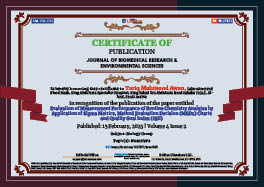Tariq Mahmood Awan*, Azza Abdelbaki Al Baiomy, Muhammad Haseeb Malik, Faisal Khulaif Al-Ruwaili, Rawan Abdelrahman and Ahlam Zohair Al-Johani
Volume4-Issue2
Dates: Received: 2023-01-10 | Accepted: 2023-02-12 | Published: 2023-02-15
Pages: 226-234
Abstract
Objective: To evaluate performance of routine chemistry analytes in a tertiary care hospital laboratory by the application of sigma metrics.
Introduction: Six sigma (6σ) is a popular Quality Management System (QMS) tool. Laboratories are increasingly using the six sigma method for the objective assessment and comparison of the analytical methods and instrument performance. Six sigma is about measuring or counting the number of defects. It quantifies the performance of a process as a rate of Defects-Per-Million-Opportunities (DPMO or DPM). The aim is to assess the performance and to eliminate or reduce the variation in a process.
Materials and Methods: This prospective study was conducted over a period of six months duration. Sigma metrics were calculated using coefficient of variation (%CV), %Bias and total allowable error (%TEa). For %CV we used Internal Quality Control (IQC) samples, at two levels L1 and L2. Daily IQC results of L1 and L2 for 25 routine chemistry analytes were recorded in an excel sheet and %CV was calculated for each analyte for the period of study. For each analyte %Bias was calculated based on values obtained from monthly RIQAS-EQA program data. The total allowable error (%TEa) values for each analyte were extracted from various sources like Clinical Laboratories Improvement Amendment act (CLIA), Canadian Fixed Limits from the College of Physicians and Surgeons of Saskatchewan (CFX) and Spanish Society of Clinical Chemistry and Molecular Pathology (SEQC) table of Desirable Quality Specifications based on Biological Variation (BV) criteria for acceptable performance. Sigma values were calculated. The minimal acceptable performance criteria was considered as 3 sigma. Normalized MEDx charts were used to plot sigma metrics to visually present the performance. Quality Goal Index (QGI) analysis was carried out as a part of Root Cause Analysis (RCA).
Results: Highest sigma value of 16.7 was noted for HDL-C and the lowest of 2.08 for chloride at level L1. Many analytes like ALP, Amylase, AST, CK, GGT, HDL-C, Magnesium and Uric Acid attained world class quality performance at both levels L1 and L2 with sigma levels of >6. Many other analytes showed satisfactory performance with sigma levels of >3. Sodium, potassium, chloride and urea did not show a satisfactory performance.
Conclusion: Sigma metrics evaluation of analytical performance of our laboratory showed an acceptable performance for a wide range of analytes in patient samples.
FullText HTML
FullText PDF
DOI: 10.37871/jbres1665
Certificate of Publication

Copyright
© 2023 Awan TM, et al. Distributed under Creative Commons CC-BY 4.0
How to cite this article
Awan TM, Al Baiomy AA, Malik MH, Al-Ruwaili FK, Abdelrahman R, Al-Johani AZ. Evaluation of Measurement Performance of Routine Chemistry Analytes by Application of Sigma Metrics, Method Evaluation Decision (MEDx) Charts and Quality Goal Index (QGI). 2023 Feb 15; 4(2): 226-234. doi: 10.37871/jbres1665, Article ID: JBRES1665, Available at: https://www.jelsciences. com/articles/jbres1665.pdf
Subject area(s)
References
- Nevalainen D, Berte L, Kraft C, Leigh E, Picaso L, Morgan T. Evaluating laboratory performance on quality indicators with the six sigma scale. Arch Pathol Lab Med. 2000 Apr;124(4):516-9. doi: 10.5858/2000-124-0516-ELPOQI. PMID: 10747306.
- Harry MJ. Six Sigma: a breakthrough strategy for profitability. Quality Progress. 1998; 31(5):60–64.
- Keleş M. Evaluation of the clinical chemistry tests analytical performance with Sigma Metric by using different quality specifications - Comparison of analyser actual performance with manufacturer data. Biochem Med (Zagreb). 2022 Feb 15;32(1):010703. doi: 10.11613/BM.2022.010703. Epub 2021 Dec 15. PMID: 34955671; PMCID: PMC8672391.
- Westgard S, Bayat H, Westgard JO. Analytical Sigma metrics: A review of Six Sigma implementation tools for medical laboratories. Biochem Med (Zagreb). 2018 Jun 15;28(2):020502. doi: 10.11613/BM.2018.020502. PMID: 30022879; PMCID: PMC6039161.
- CLIA proficiency testing criteria for acceptable analytical performance: Federal Register 1992 Feb 28;57(40):7002-186.
- Tietz–Westgard JO and Klee GG. Quality Management. In: Burtis CA, Ashwood ER, Bruns DE, eds. Tietz Textbook of Clinical Chemistry and Molecular Diagnostics. 4th ed. Philadelphia: Elsevier Saunders, 2006:488-9
- Parry DM. Quality Goal Index.
- Westgard JO, Westgard SA. Quality control review: implementing a scientifically based quality control system. Ann Clin Biochem. 2016 Jan;53(Pt 1):32-50. doi: 10.1177/0004563215597248. Epub 2015 Jul 6. PMID: 26150675.
- Westgard JO, Westgard SA. Establishing Evidence-Based Statistical Quality Control Practices. Am J Clin Pathol. 2019 Mar 1;151(4):364-370. doi: 10.1093/ajcp/aqy158. PMID: 30517600.
- Westgard JO. Statistical quality control procedures. Clin Lab Med 2013;33(1):111-24
- Sharma LK, Datta RR, Sharma N. Sigma metrics evaluation of drugs in a clinical laboratory: Importance of choosing appropriate total allowable error and a troubleshooting roadmap. J Lab Physicians. 2021 Mar;13(1):44-49. doi: 10.1055/s-0041-1726572. Epub 2021 May 21. PMID: 34103878; PMCID: PMC8159660.
- C24 A4: Statistical quality control for quantitative measurement procedures: Principles and Definitions, 4th Edition. CLSI., Wayne, PA, 2016.
- Aggarwal K, et al. Application of six sigma metrics and method decision charts in improvising clinical Chemistry laboratory performance enhancement. Int J Adv Med. 2019 Oct;6(5):1524-1530.
- Cooper G, DeJonge N, Ehrmeyer S, Yundt-Pacheco J, Jansen R, Ricós C, Plebani M. Collective opinion paper on findings of the 2010 convocation of experts on laboratory quality. Clin Chem Lab Med. 2011 May;49(5):793-802. doi: 10.1515/CCLM.2011.149. Epub 2011 Mar 3. PMID: 21366504.
- Shah S, Saini R, Singh SB, Aggarwal O, Goel AK. Six Sigma Metrics and Quality Control in clinical laboratory. Int J Med Res Rev. 2014;2(2):140-149.






























































